Tender pork cutlets in my Tonkatsu recipe are breaded in airy and fluffy Japanese panko and then deep-fried until juicy, crisp, and golden. Serve them with my irresistible sesame tonkatsu sauce for an extra savory touch!
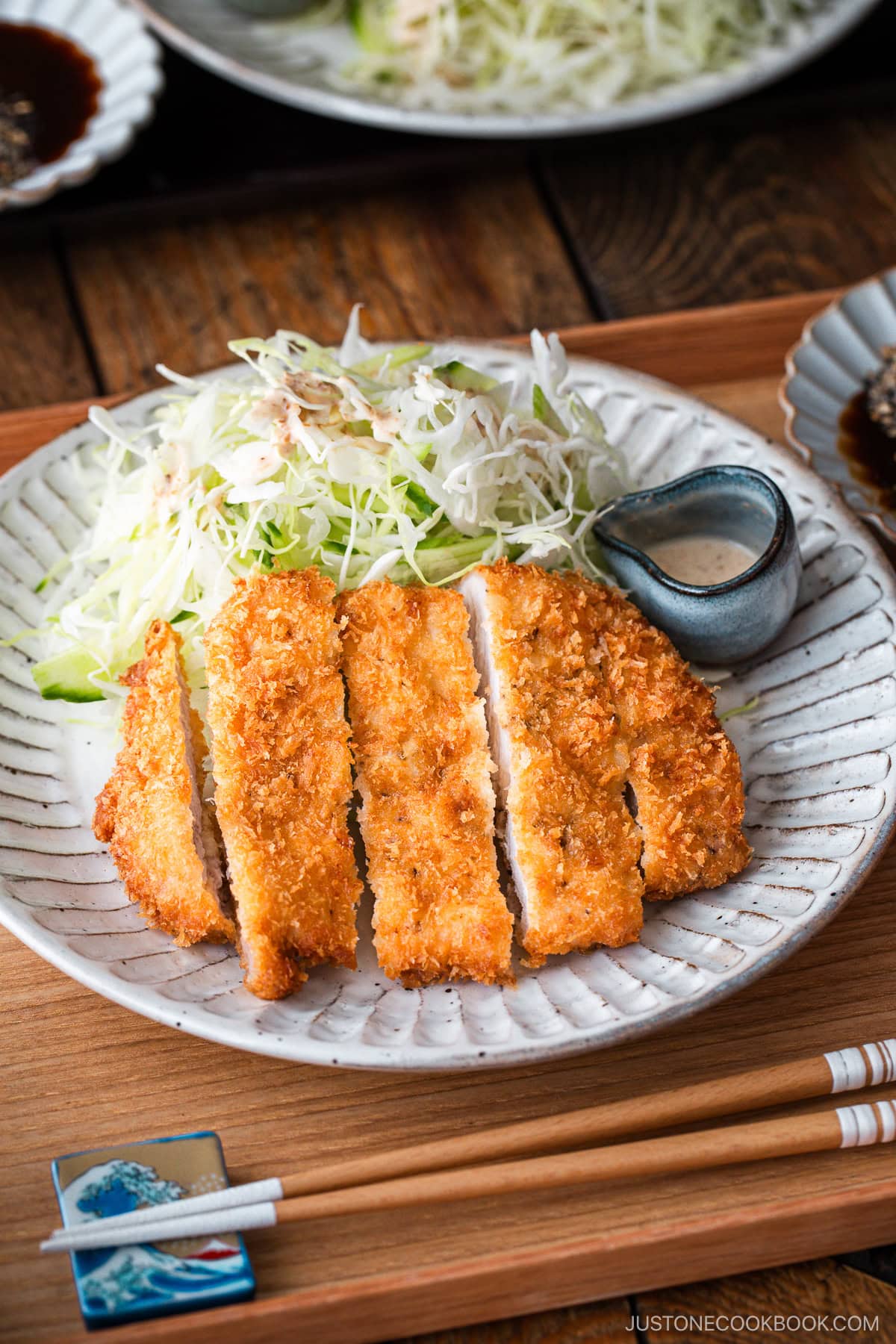
Tonkatsu is one of the many Western-inspired dishes that’s become synonymous with Japanese comfort food. It’s composed of crispy, deep-fried pork cutlets, and it’s easier to make than you think. I’ll share my secrets for a light and airy breading and succulent, tender meat.
If you’re looking for more katsu recipes, try my Katsu Curry, Katsu Sando, and Baked Chicken Katsu next!
What is Tonkatsu?
Tonkatsu (とんかつ, 豚かつ) is tender pork loin that’s breaded in Japanese panko breadcrumbs and deep-fried until golden. The word ton (豚) comes from “pork,” while katsu (カツ) is derived from the word “cutlet.” Fried cutlets in Japan appeared in the 1870s and were primarily made using beef. After much tinkering, the original French recipe was adapted to suit the Japanese palate. Today, it’s much-loved and widely available in countless Japanese specialty restaurants.
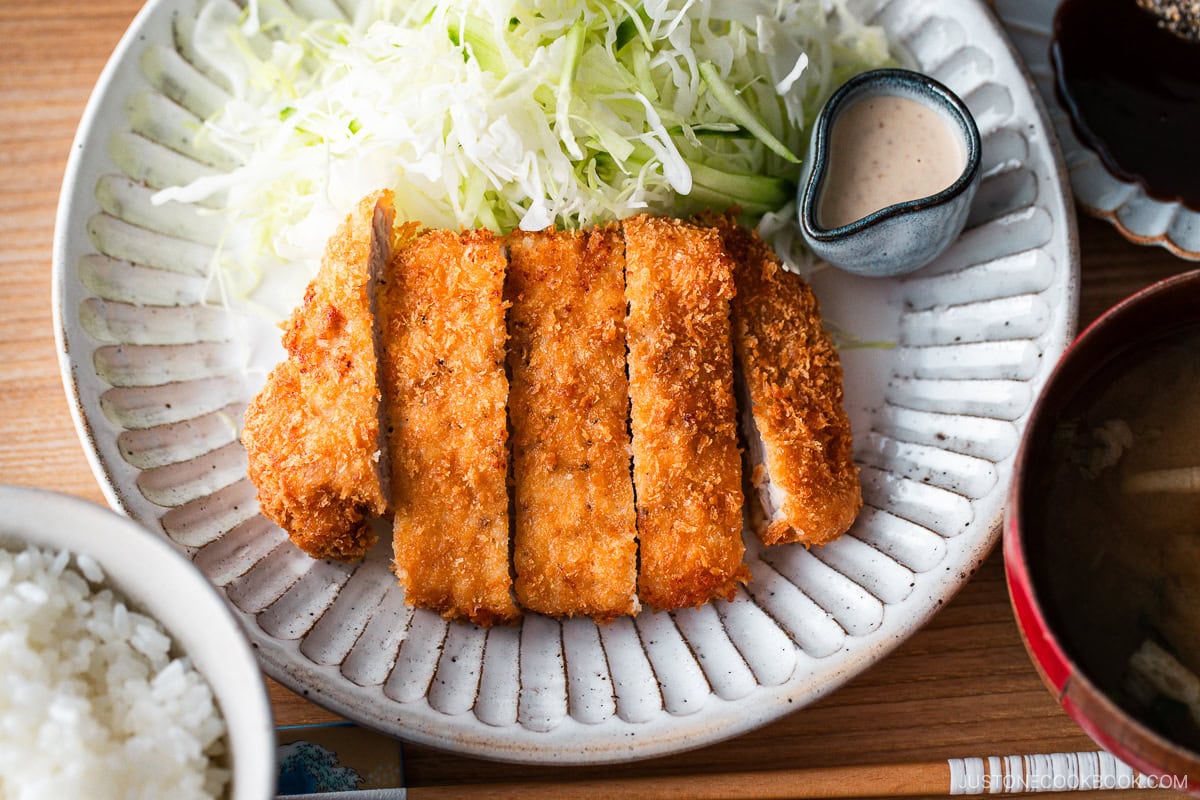
Why I Love This Recipe
- The light and crispy breading – I use flaky panko breadcrumbs for their light, fine, and supercrisp crunch.
- A versatile recipe – We typically serve tonkatsu with a heaping pile of cabbage and a side of pickles, but you could cook it over tender onions and serve it on rice to make my favorite donburi, Katsudon.
- Simple, yet irresistible – The ingredient list is short, and the cook time is minimal, yet you’re left with a richly flavored and textured dish everyone will love.
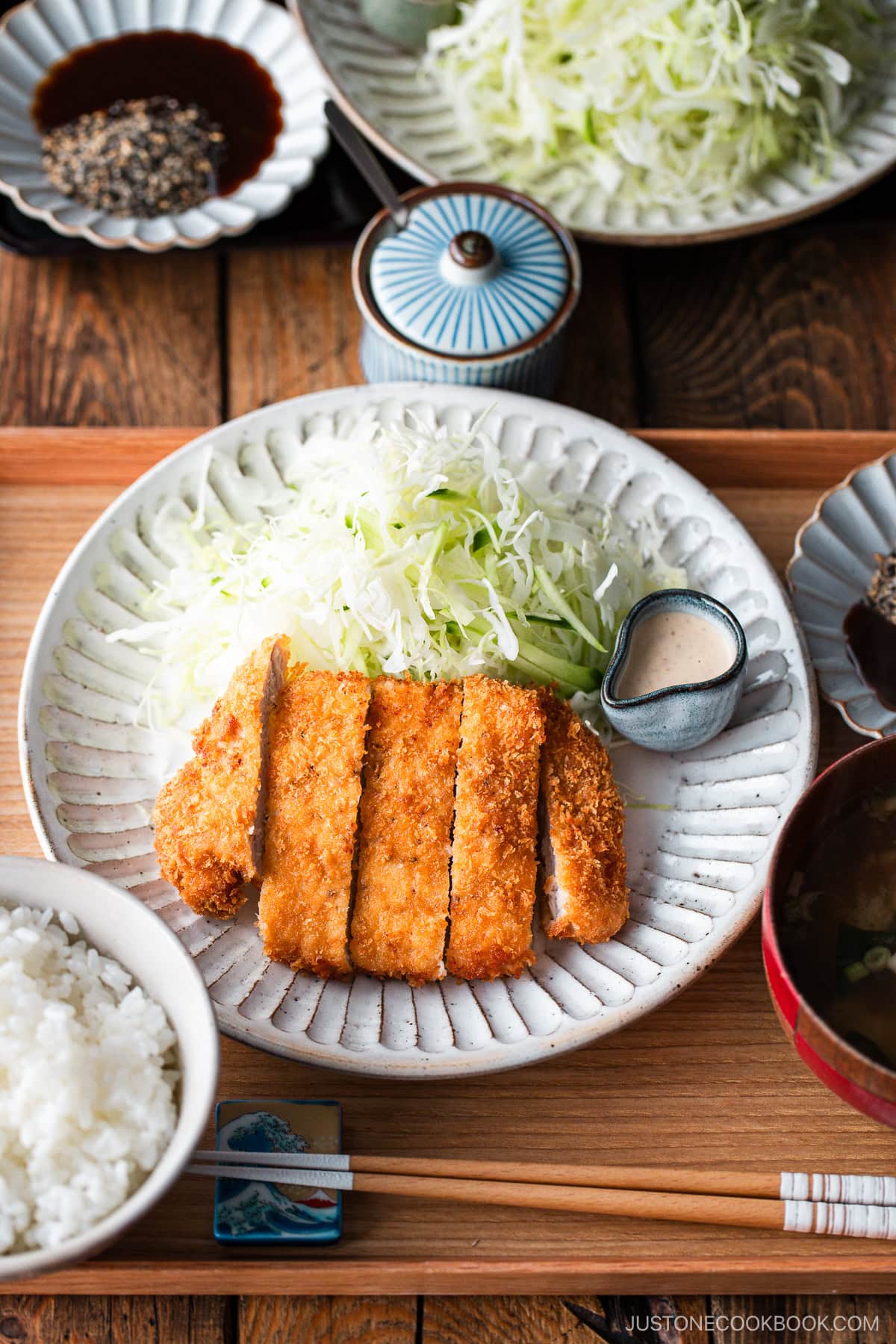
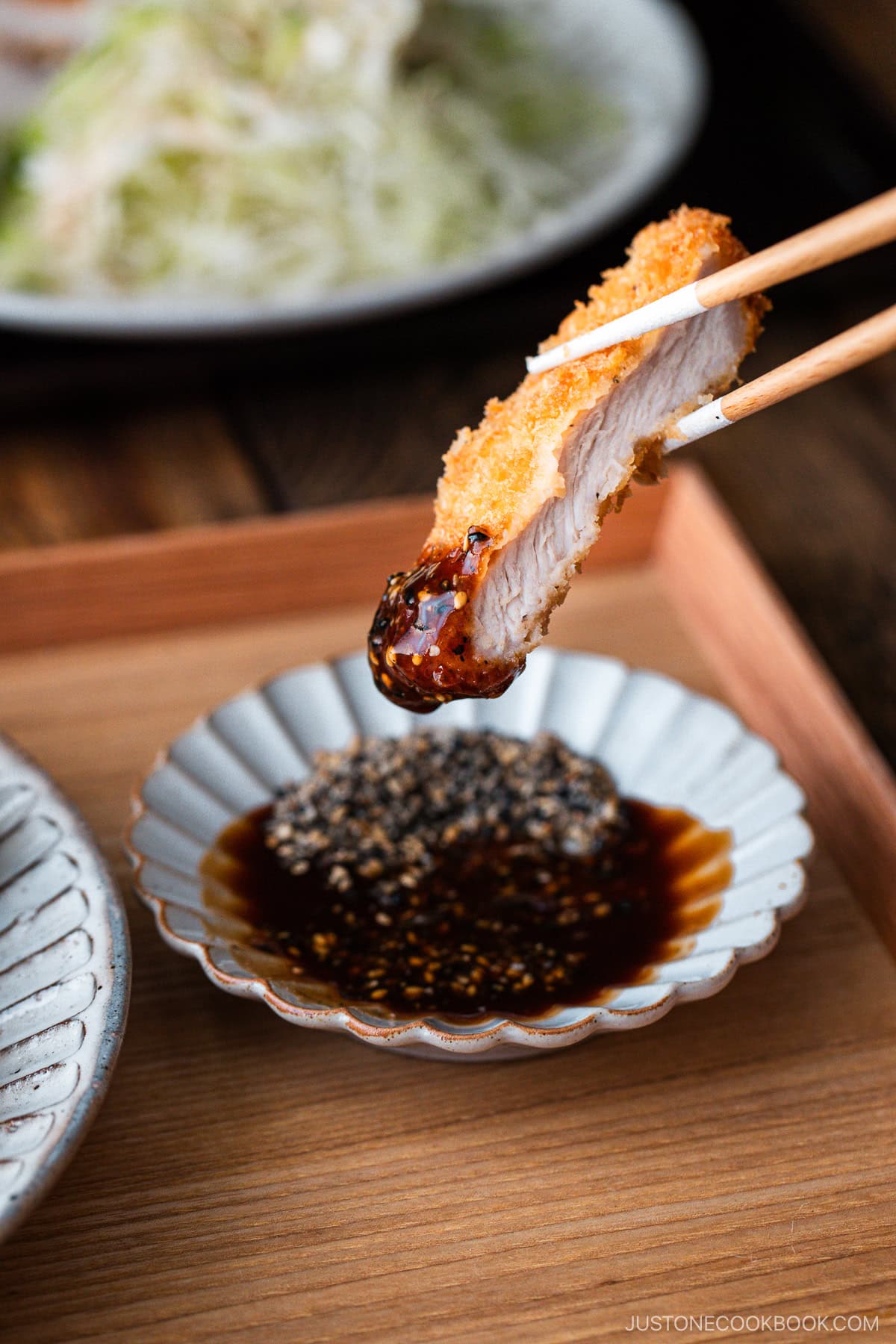
Ingredients for Tonkatsu
- Pork loin or pork fillet – Use either pork loin or pork tenderloin, as they have an essential layer of fat that gives the meat an extra tender bite.
- Salt and black pepper
- All-purpose flour
- Eggs
- Panko breadcrumbs
- Any neutral flavored oil, such as vegetable oil – for deep-frying
- Tonkatsu sauce
- Black and white sesame seeds – optional, for the dipping sauce
Find the printable recipe with measurements below.
Substitutions
- Pork loin: You can use chicken to make Chicken Katsu!
- Tonkatsu sauce: This savory, tangy sauce can be bought in any Japanese grocery store or Amazon. I prefer making Homemade Tonkatsu Sauce with Worcestershire sauce, oyster sauce, ketchup, and sugar because it’s so easy and just as delicious.
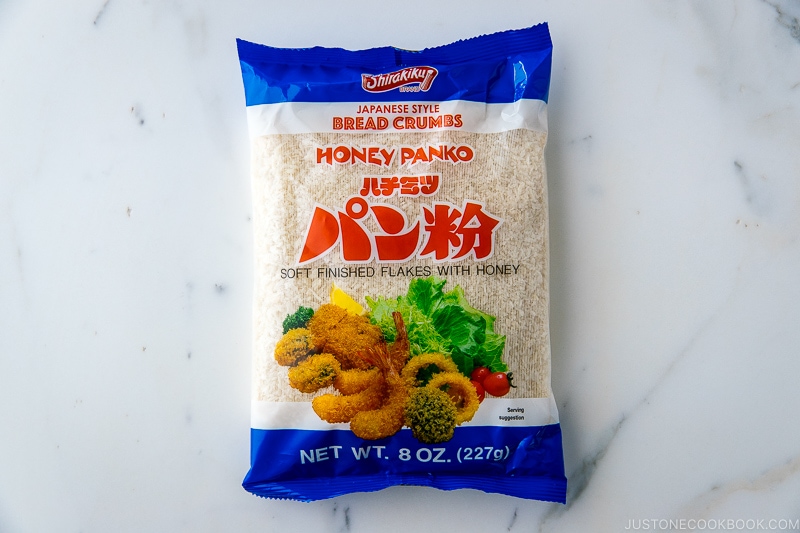
What’s Japanese Panko?
These Japanese-style breadcrumbs are made from soft, crustless Japanese milk bread. Their large flakey texture absorbs less oil than finely ground breadcrumbs, creating a light, crisp coating. Try to find a Japanese brand, as non-Japanese versions differ in texture. You can get Japanese panko from Amazon or at Japanese/Asian grocery stores.
In Japan, we often use nama panko (生パン粉), a fresh version with more moisture content than dried panko resulting in a better texture. To recreate it, I lightly spray dried panko wtih water to rehydrate it before coating the cutlets.
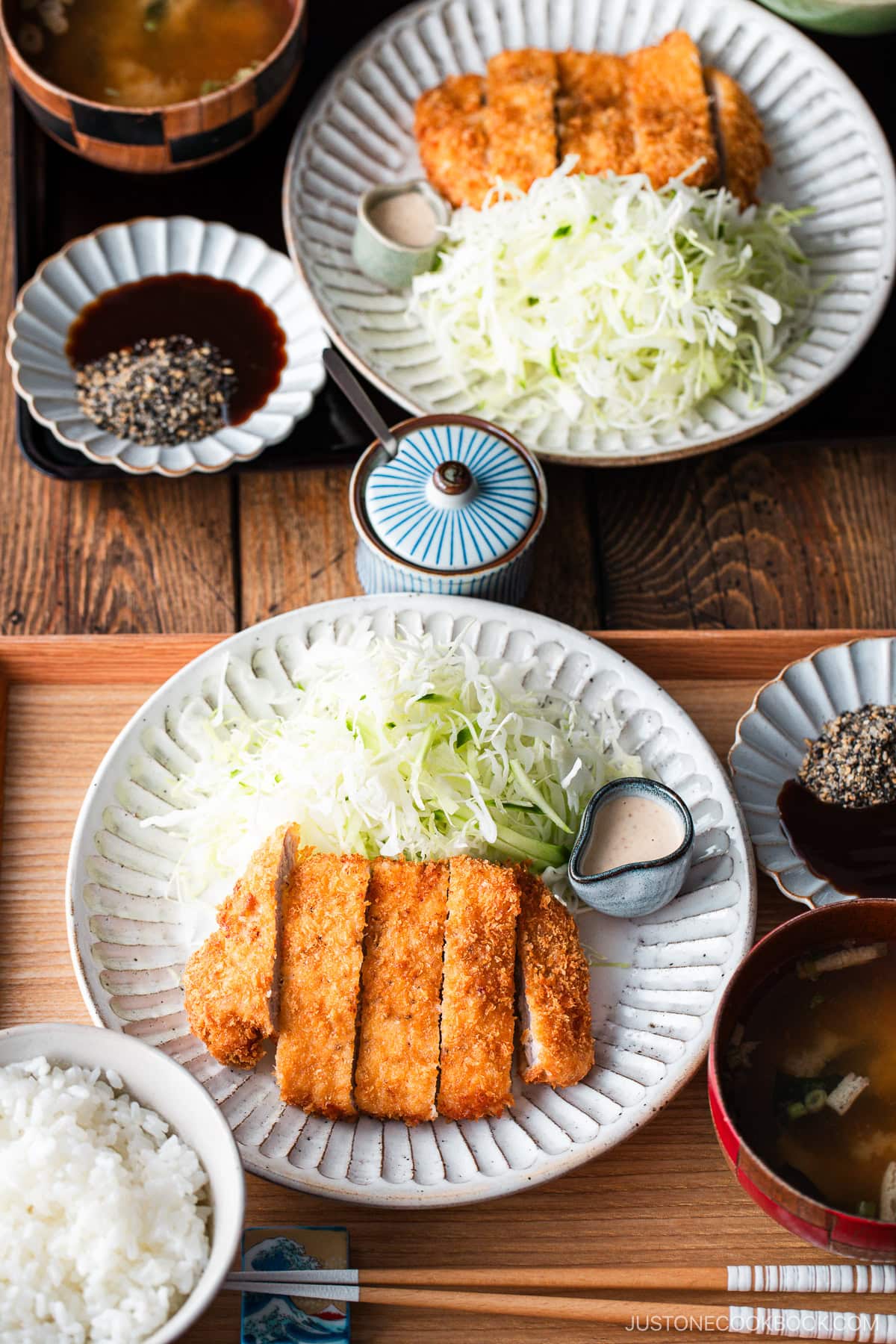
How to Make Tonkatsu
Preparation
Step 1 – Make the dipping sauce. Grind the sesame seeds in a mortar and pestle. Divide the powder into small sauce bowls and top with tonkatsu sauce.
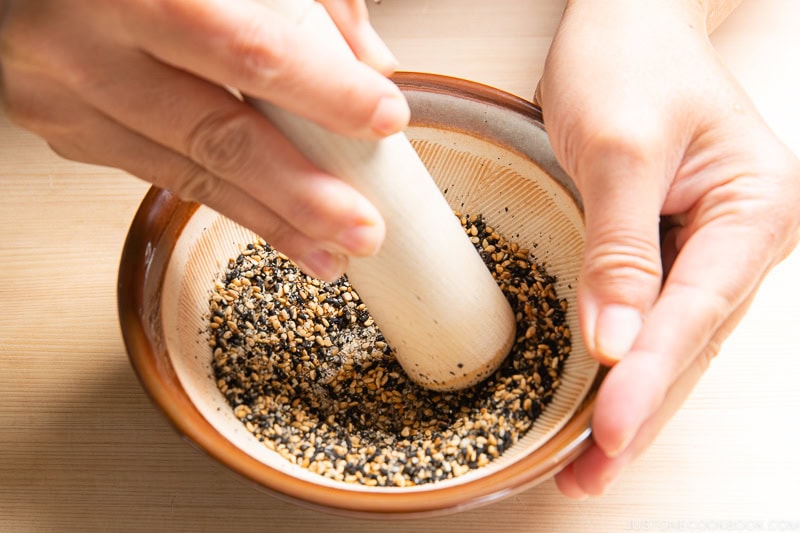
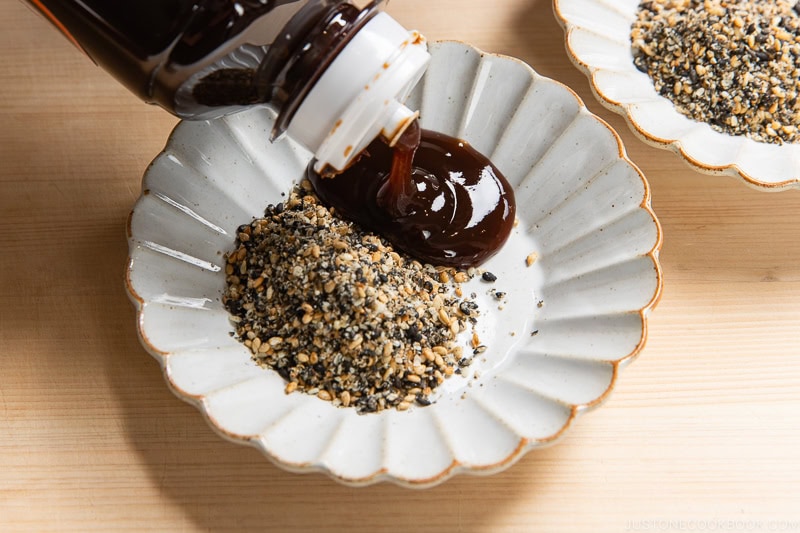
Step 2 – Prepare the pork. Trim the excess fat from the meat and cut slits into the connective tissue on both sides. Pound the pork with a meat mallet, then season with salt and pepper.
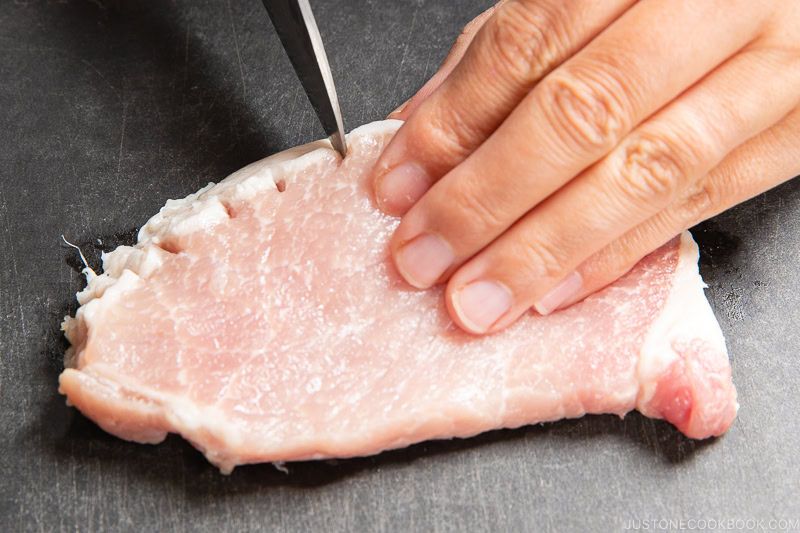
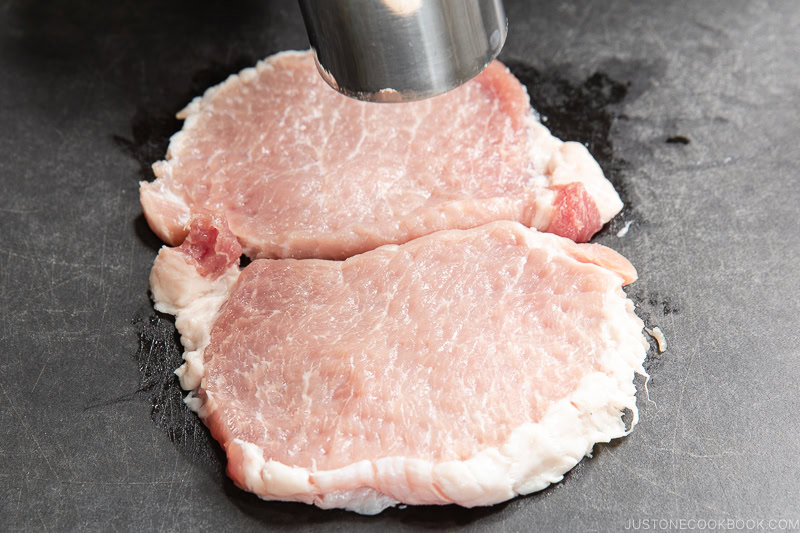
Step 3—Set up the breading station and heat the oil. Lay out three shallow trays or plates. Add the breadcrumbs to one. Add the beaten eggs and oil to the second, then whisk to combine. Add flour to the third. Add the oil to a deep pot and heat on medium until it reaches 340ºF (170ºC).
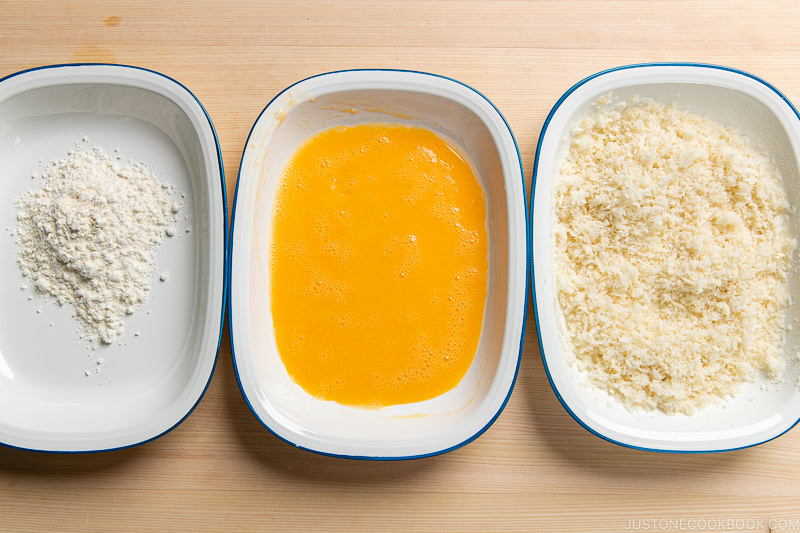
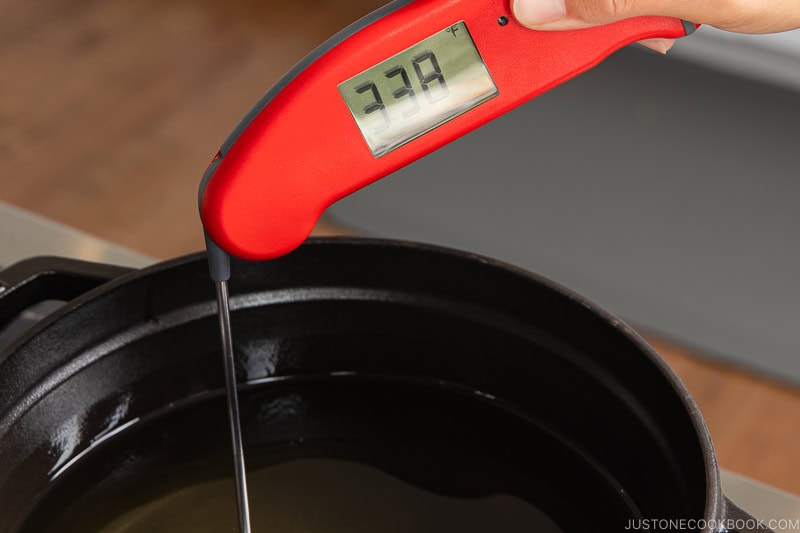
Step 4 – Bread the pork. Dredge the cutlets in flour, then the egg mixture, then the panko mixture.
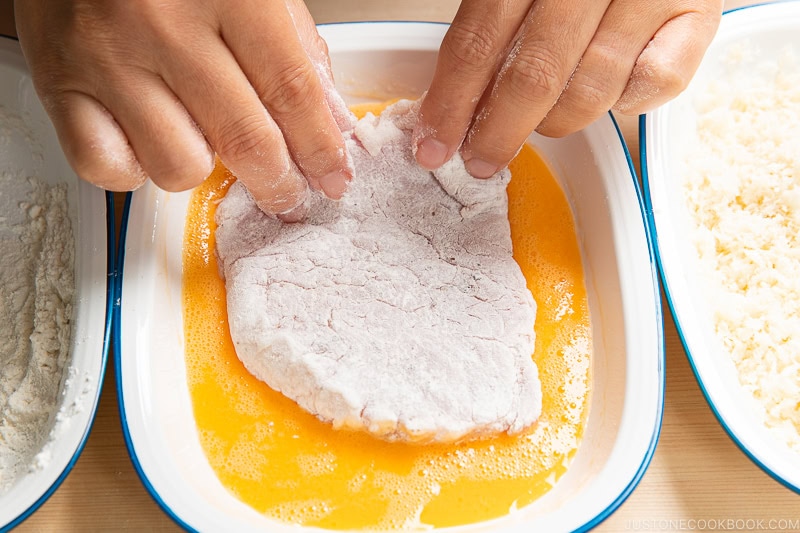
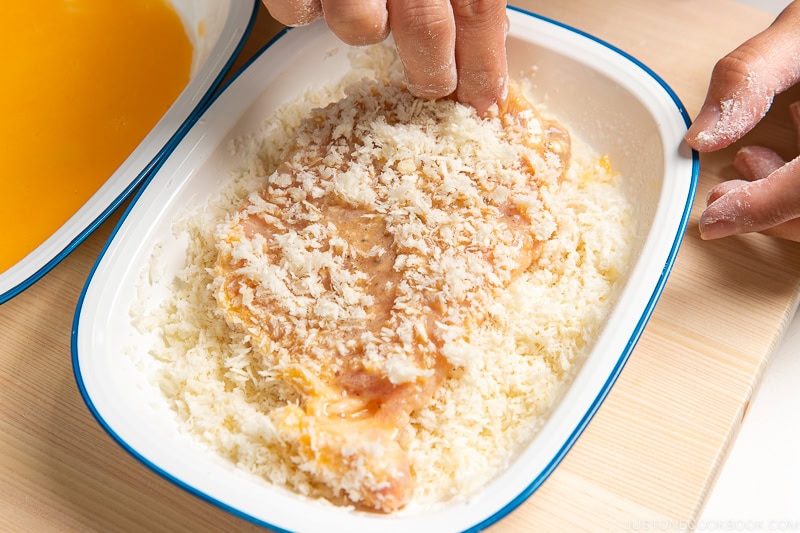
Cooking
Step 5 – Fry. Add one cutlet to the hot oil and cook for 1 minute, then flip and cook for another minute. Transfer the fried cutlet to a wire rack and repeat until all cutlets are fried.
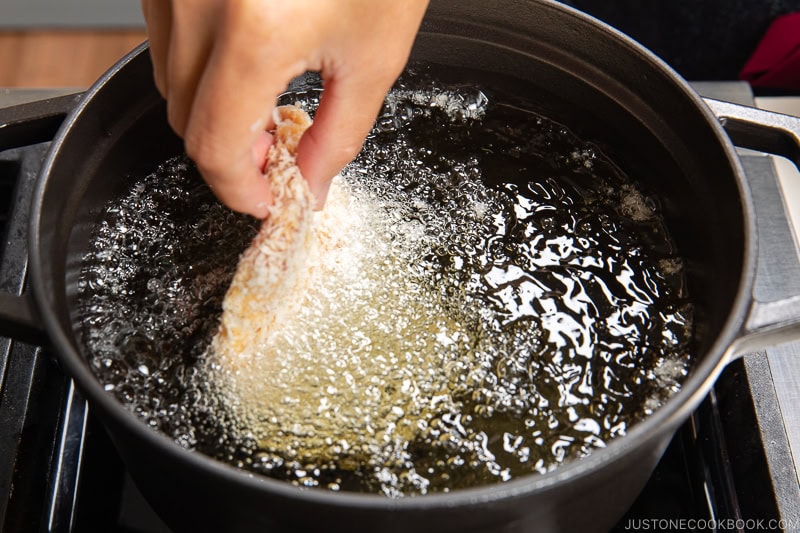
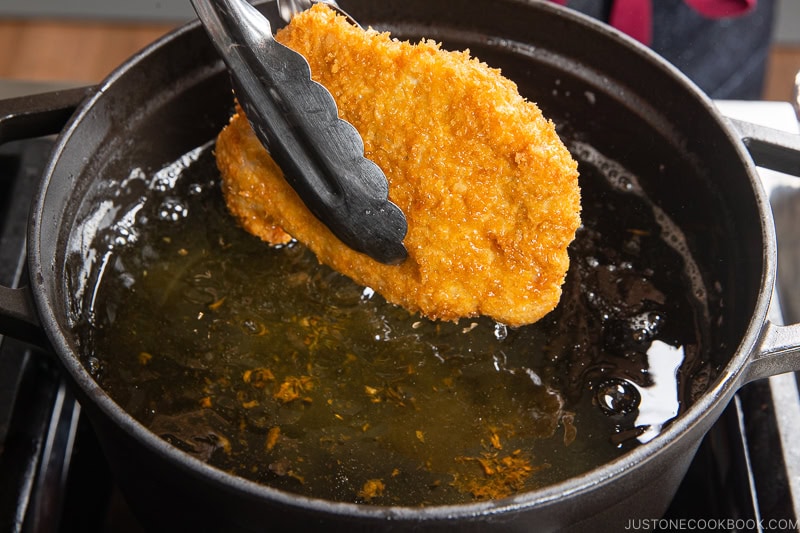
Step 6 – Fry a second time. Raise the oil temperature to 355°F (180°C), then fry one cutlet for 30 seconds on each side. Transfer it to a wire rack and clean the oil with a fine-mesh skimmer. Repeat with the other cutlets.
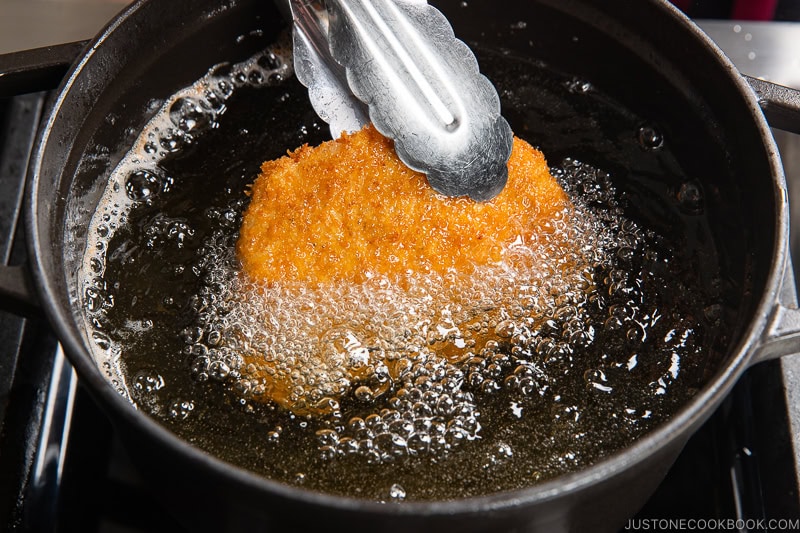
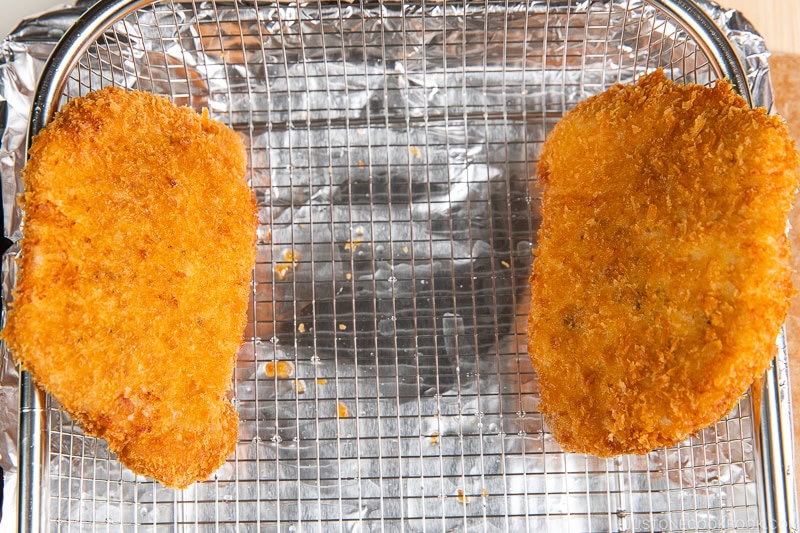
Assemble
Step 7 – Cut and serve. Slice the cutlets into ¾-inch-thick pieces, then serve with the dipping sauce.
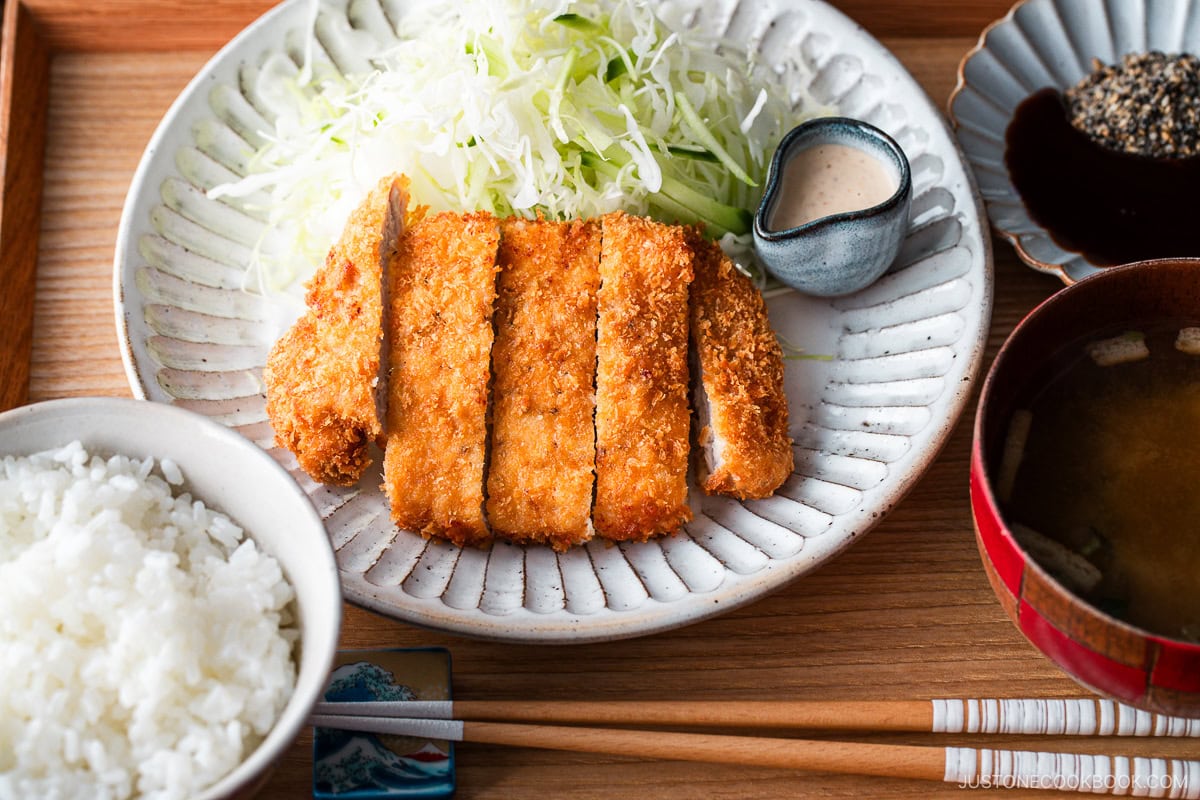
Nami’s Recipe Tips
- Shake off the excess flour – This will prevent flour and panko from falling into the oil, which would make the oil dark and affect the tonkatsu’s flavor.
- Monitor the oil temperature – The fastest and most accurate way to keep the oil at the optimal temperature is with an instant-read thermometer. I highly recommend using one so there’s no guesswork involved.
- Don’t crowd the pot – As tempting as it may be, you don’t want to crowd the oil with too many cutlets. This will cause the oil temperature to drop, and the pork won’t cook as evenly.
- Double-fry – I’ve found the key to perfectly cooked tonkatsu is to fry it, let it sit on a wire rack for several minutes, then fry it a second time to get that crispy, golden exterior.
- Clean the oil between batches – Scoop up the fried crumbs in the oil with a fine-mesh strainer. This way, the oil stays clean and the crumbs won’t darken or stick to your crust.
Variations and Customizations
Tonkatsu is a simple dish that can be easily modified or enhanced with other elements. Here are some of my suggestions.
- Add spices to the breadcrumbs. For a more intense aroma and flavor, you can add a few teaspoons of garlic powder, onion powder, and/or ginger powder to the flour.
- Bake it instead. If you would prefer not to deep-fry the pork, try my Baked Tonkatsu. It’s just as delicious, without the deep-frying cleanup!
- Skip the sesame seeds. You can serve this dish the standard way with straight tonkatsu sauce. We do this all the time!
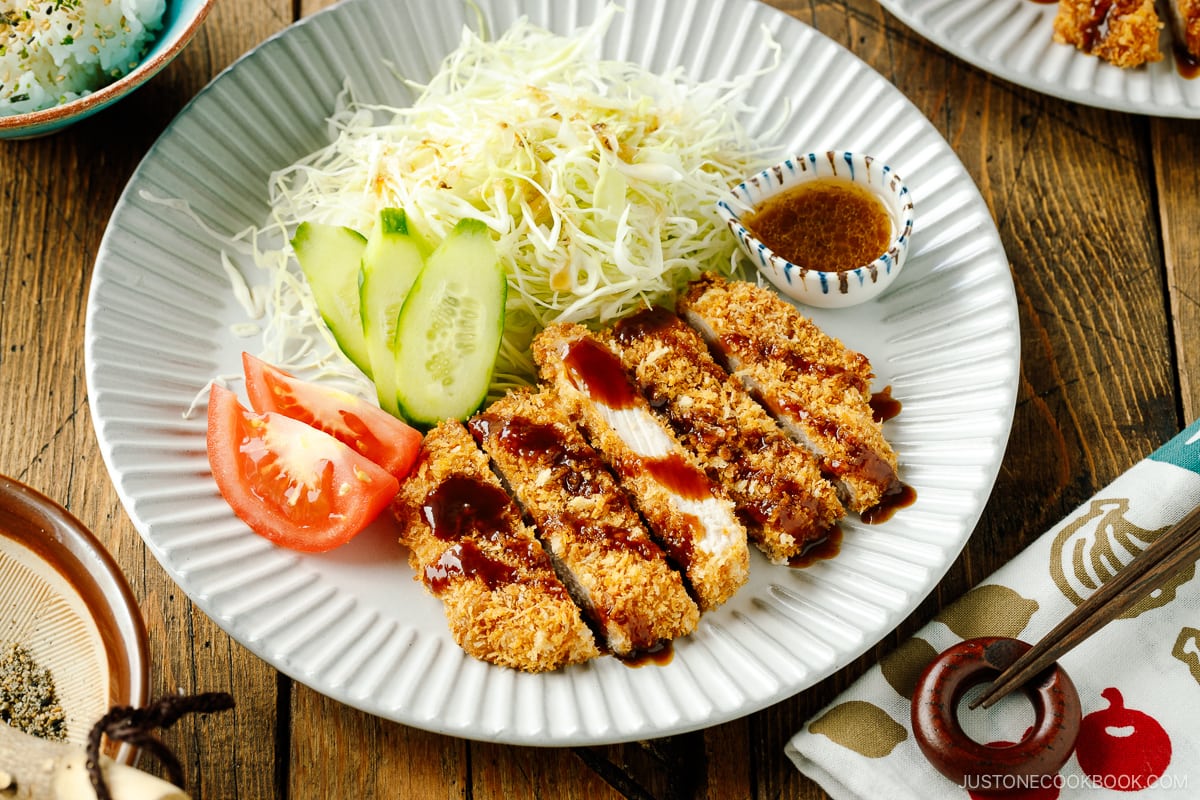
What to Serve with Tonkatsu
- Make cabbage slaw – I often serve Tonkatsu with a simple cabbage and cucumber slaw. Toss the slaw in Japanese Sesame Dressing (or any Asian dressing of your choice).
- With pickles – Serving it with Asazuke not only imparts a slightly sweet and salty flavor but also creates a lovely textural contrast.
- With hearty soup – Tonjiru or Asari Miso Soup is commonly served at Tonkatsu restaurants, making them the perfect companion.
- With rice – It’s easy to make Japanese Short-Grain Brown Rice in a rice cooker.
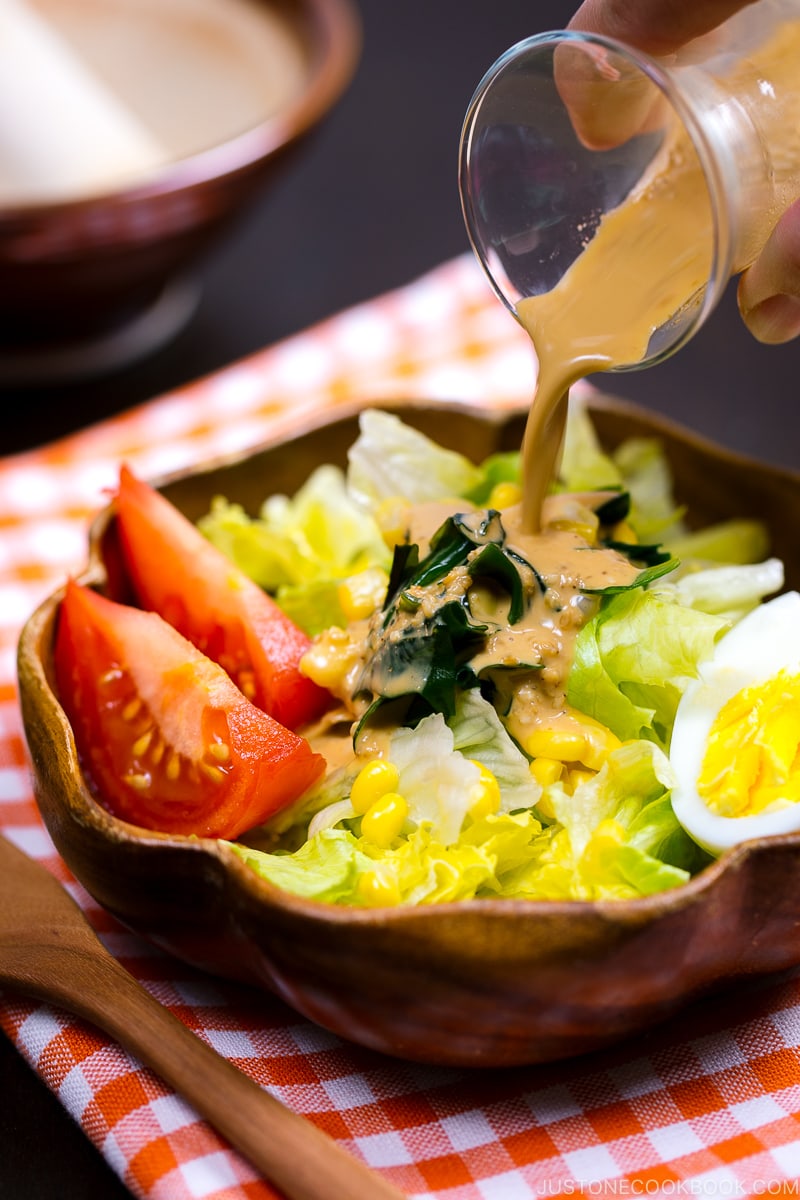
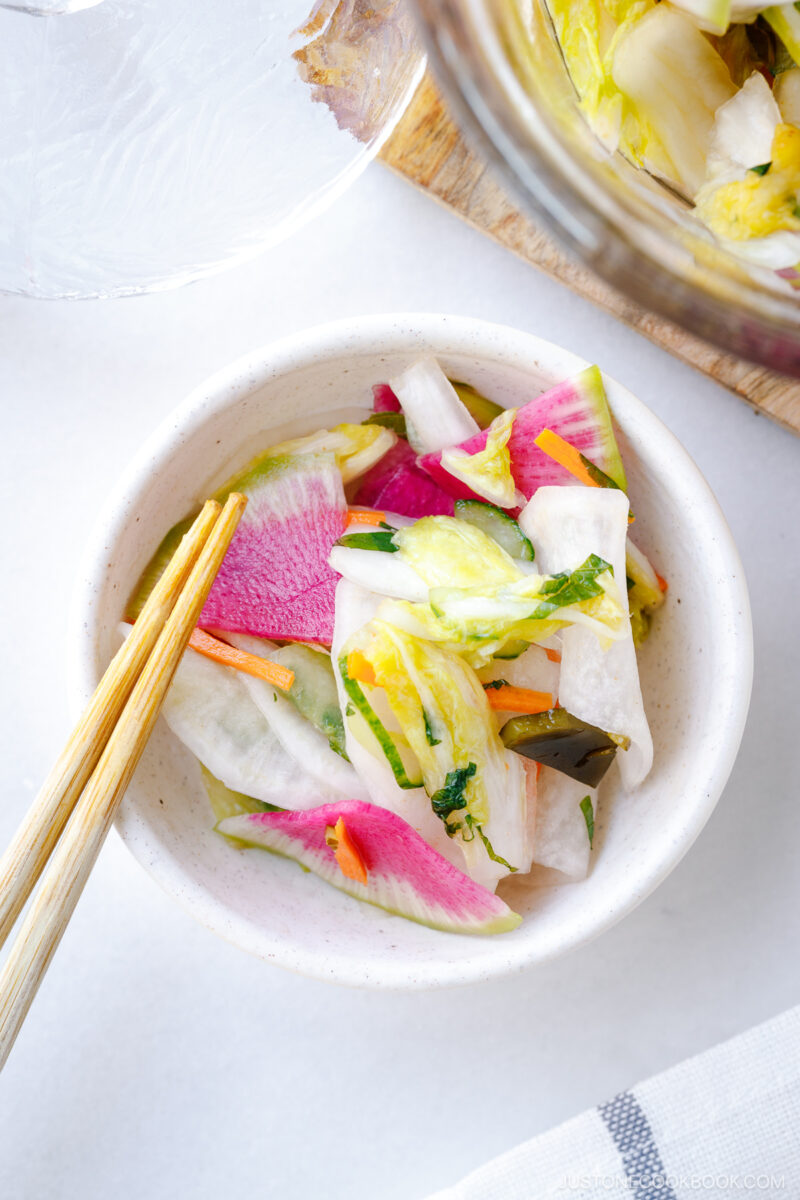
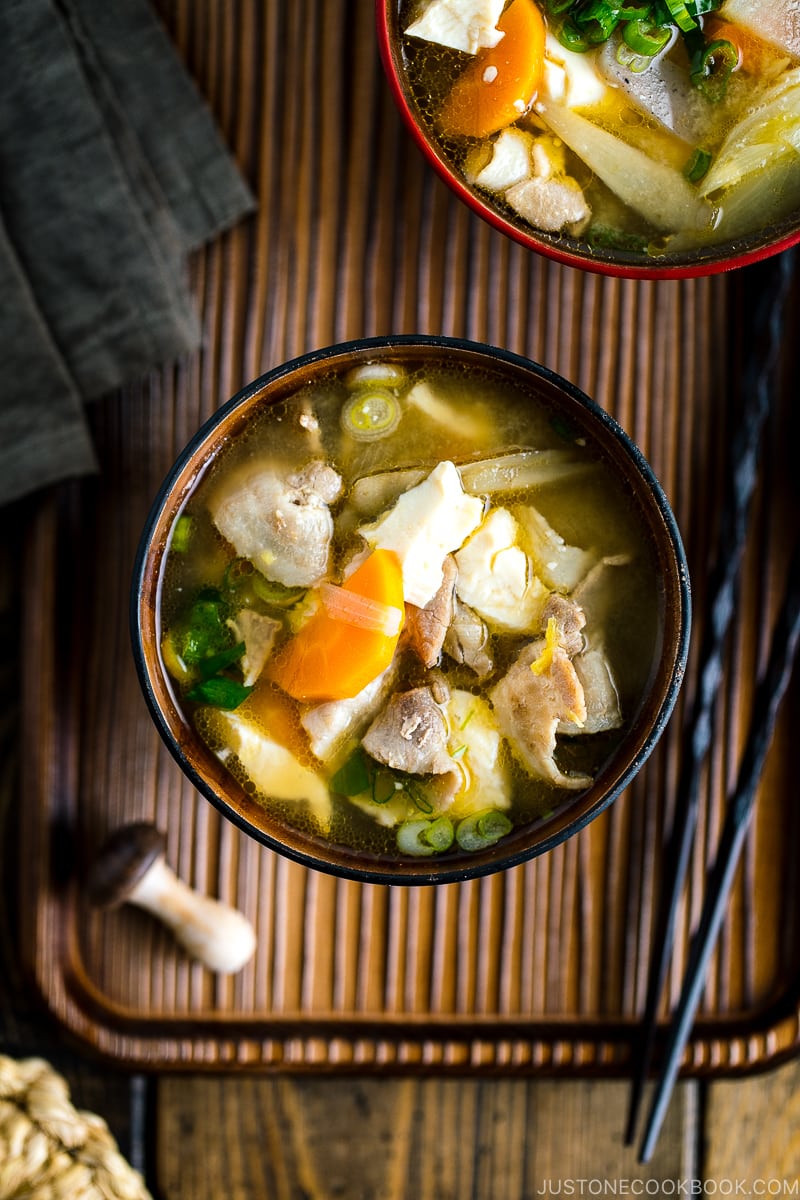
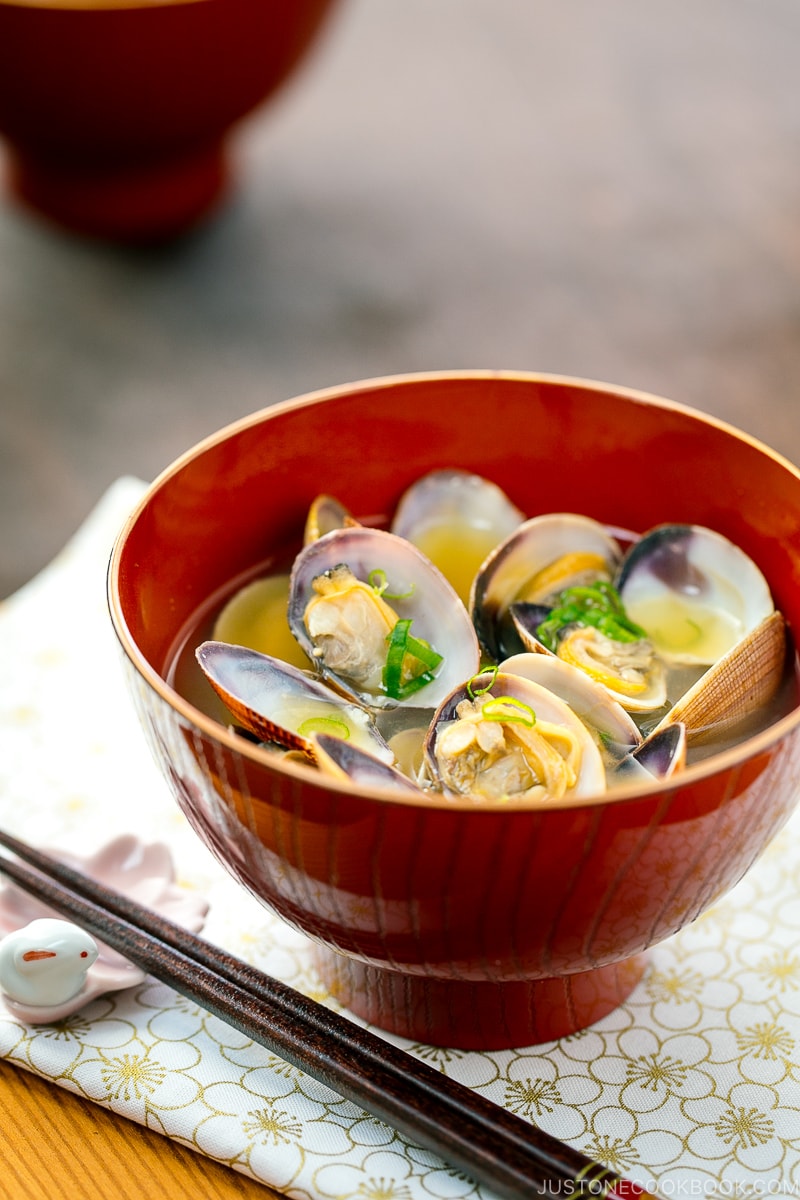
Storage and Reheating Tips
To store: Once the tonkatsu has cooled completely, store in an airtight container in the fridge for 3–4 days or in the freezer for up to 3–4 months.
To reheat: Reheat leftover cutlets in the oven and bake at 350ºF (180ºC) for 15–20 minutes if defrosted or 30–40 minutes if frozen.
Frequently Asked Questions
How do I dispose of cooking oil?
Since you do not want to pour oil down the drain, I suggest buying an oil-solidifying powder for easier removal (see the brand I use in my recipe card). Alternatively, let the oil cool completely, then pour it into an empty container and place it in the garbage.
Why did the pork become tough?
It’s likely the pork was overcooked. When in doubt, use an instant-read thermometer to check the internal temperature of the pork. Ideally, the pork should register an internal temperature of 145°F. Cook it any longer, and you risk the meat becoming overcooked and chewy.
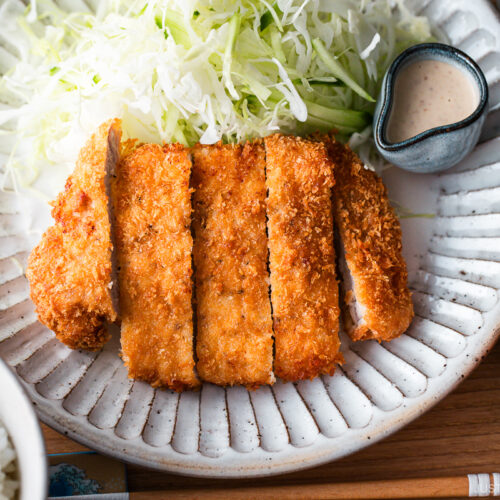
Prep Time: 15 minutes
Cook Time: 15 minutes
Total Time: 30 minutes
For the Breading
- ▢ ½ cup panko (Japanese breadcrumbs) (or more, as needed; use fresh nama panko (生パン粉), if available; see how to make it with dried panko in the recipe)
- ▢ 1 large egg (50 g each w/o shell)
- ▢ ½ Tbsp neutral oil (for the egg)
- ▢ 2 Tbsp all-purpose flour (plain flour)
For the Tonkatsu
- ▢ 2 boneless pork loin chops (½ inch thick) (100 g, 3.5 oz per piece; ½ inch, 1–1.3 cm thick)
- ▢ ½ tsp Diamond Crystal kosher salt
- ▢ ⅛ tsp freshly ground black pepper
- ▢ 3 cups neutral oil (or enough for 1¾–2 inches (5 cm) of oil in the pot, for deep-frying)
Japanese Ingredient Substitution: If you want substitutes for Japanese condiments and ingredients, click here.
If you prefer not to deep-fry, see my recipe for Baked Tonkatsu.
Gather all the ingredients. I highly recommend using fresh panko (called nama panko) from a Japanese grocery store, if available. If you can’t get it, follow my instructions below to make fresh panko using dried panko. Make sure to use a Japanese brand of panko from Japan. Western “panko breadcrumbs” are a bit different from authentic Japanese panko.
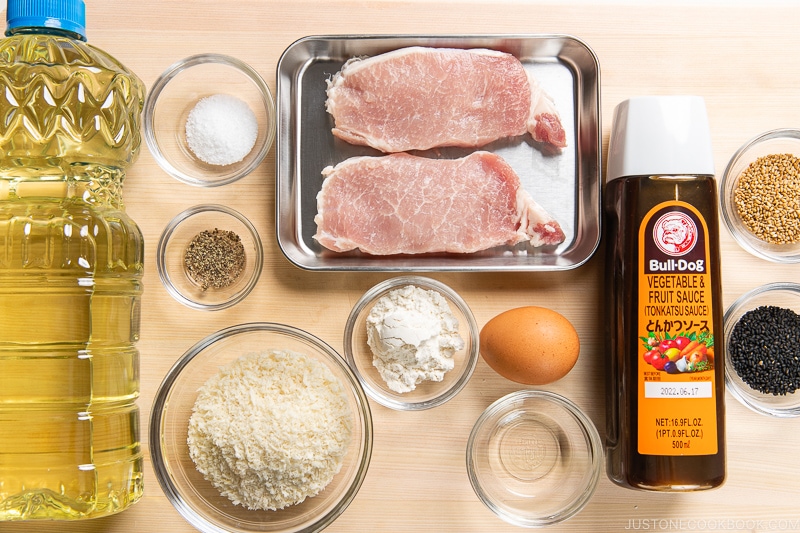
To Prepare the Shredded Cabbage (optional)
In Japan, we serve tonkatsu with a side of fresh shredded cabbage. To prepare it, shred ¼ head green cabbage very finely with a sharp knife or slicer. I love to use a cabbage slicer (you can get one from Amazon or JOC Goods) because it saves time and energy! I also thinly slice 1 Japanese or Persian cucumber diagonally, then cut them into thin strips. Toss the cabbage and cucumber together and set aside. Prepare 4 Tbsp Japanese sesame dressing (store bought or make homemade Japanese Sesame Dressing) and keep refrigerated until ready to serve.
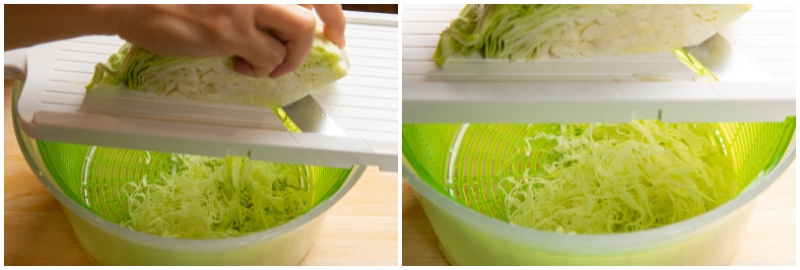
To Make the Dipping Sauce
Grind 1 Tbsp toasted white sesame seeds and 1 Tbsp toasted black sesame seeds with a Japanese mortar and pestle. Leave some seeds unground for texture.
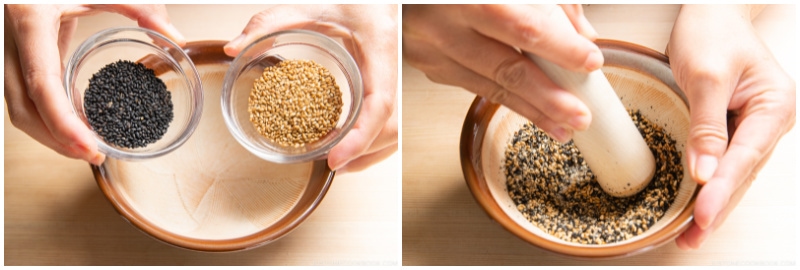
Divide the ground sesame seeds among individual dipping plates or bowls. Then divide 4 Tbsp tonkatsu sauce (store bought or homemade) among them. Set aside until ready to serve. Each person can mix it together when ready to eat. Note: In Japan, we often drizzle straight tonkatsu sauce on our cutlets without adding sesame seeds. Feel free to serve this dish with straight tonkatsu sauce instead, if you prefer.
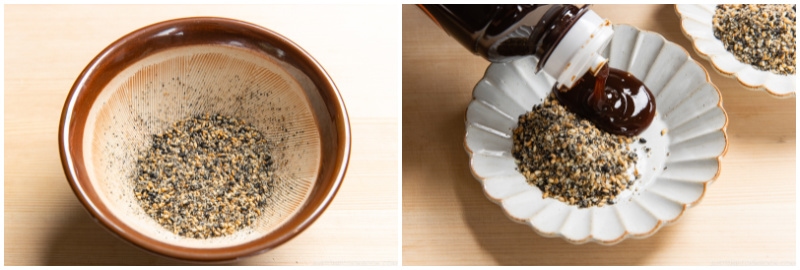
To Prepare the Fresh Panko and Breading
If you are using dry panko from the store, place ½ cup panko (Japanese breadcrumbs) in a deep dish and spray with water until the panko is moist (I use a mister). Set aside for 15 minutes, or until the panko becomes soft and tender. Optionally, you can make fresh panko by pulsing some Shokupan (Japanese Pullman bread) in a food processor.
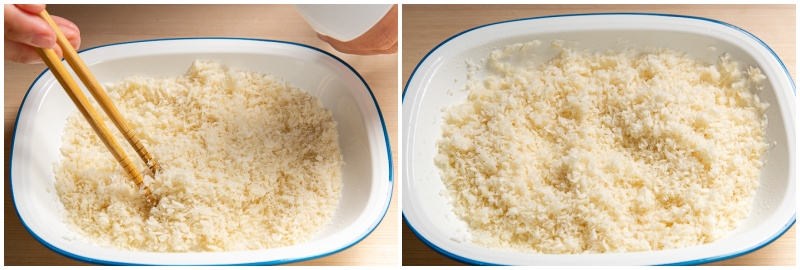
Meanwhile, prepare the other breading ingredients. Crack 1 large egg (50 g each w/o shell) into a deep dish or tray (or use my favorite prep trays from JOC Goods). Add ½ Tbsp neutral oil and whisk together until well combined. Then, prepare another dish or tray with 2 Tbsp all-purpose flour (plain flour). Tip: By adding oil, the breading won’t detach from the meat while deep-frying and this will help seal in the meat's juices and flavor.
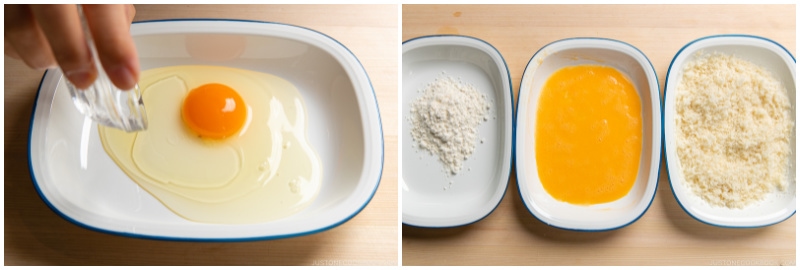
To Prepare the Pork
Use a sharp knife to remove the extra fat from 2 boneless pork loin chops (½ inch thick). Then, make several small slits on the connective tissue (the white area) between the meat and fat. Tip: Red meat and fat have different elasticities, and they shrink and expand at different rates while cooking. These slits will allow the tonkatsu to stay flat during cooking instead of curling up.
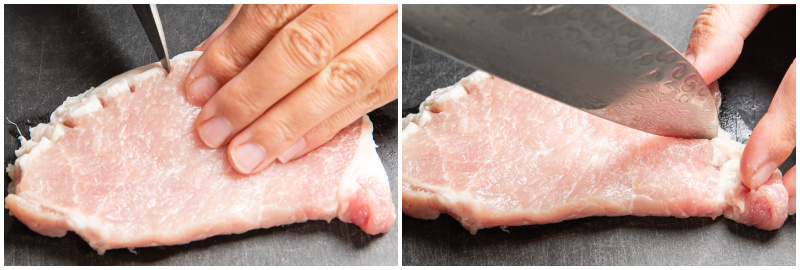
Flip the meat and make several slits on the other side of the connective tissue.
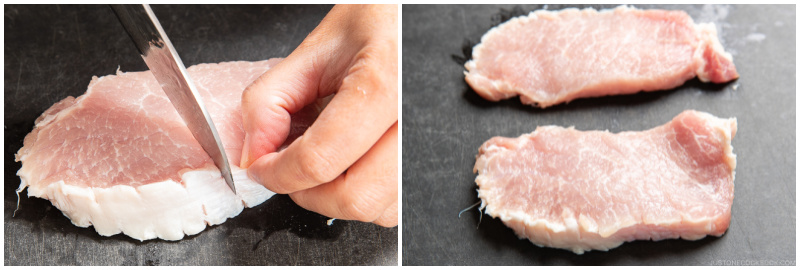
Pound both sides of the meat with the back of a knife or a meat tenderizer/mallet.
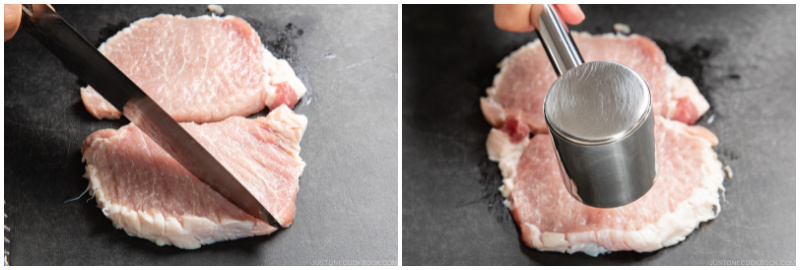
Mold the cutlet back into its original shape with your hands.
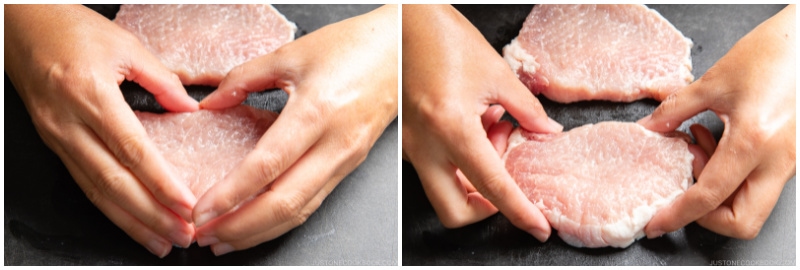
Season both sides with ½ tsp Diamond Crystal kosher salt and ⅛ tsp freshly ground black pepper.
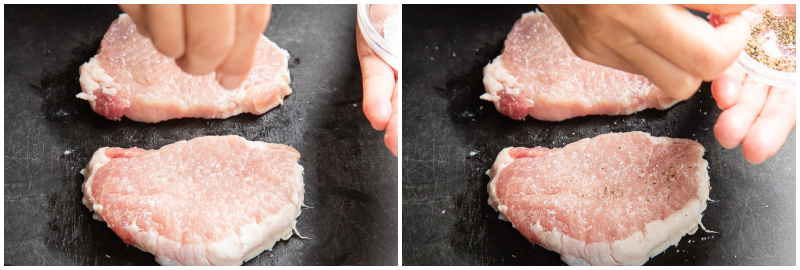
To Bread the Pork
First, dredge the pork in the flour and dust off any excess. Next, dip the pork into the egg mixture and coat well. Tip: Excess flour will prevent the egg mixture from adhering to the pork.
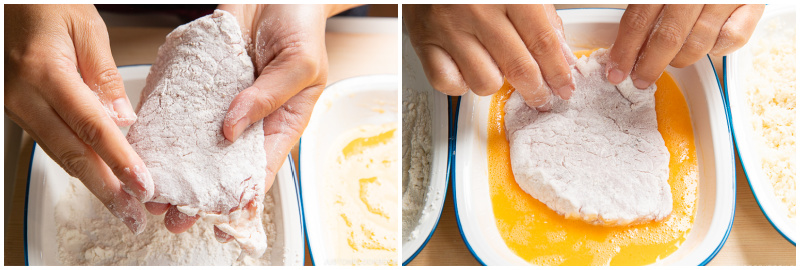
Lastly, dredge the pork in the fresh panko and gently press it to adhere to the cutlet. Gently shake off any excess, then place the breaded cutlets onto a tray or plate. Set them aside for 5–10 minutes to set the breading. Tip: The panko will “puff up” while deep-frying, so it doesn't have to be fluffy at this stage.
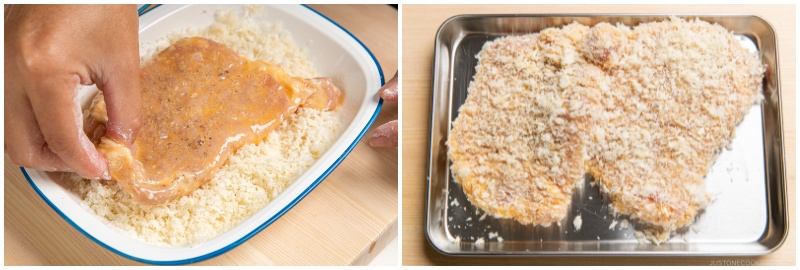
To Cook: The First Fry
Add 3 cups neutral oil to a pot. Make sure your oil is 1¾–2 inches (5 cm) deep. I use the tip of a chopstick to measure. Preheat on medium heat and bring the oil to 340ºF (170ºC). Tip: If you don’t have a thermometer, stick a chopstick in the oil; if you see tiny bubbles appear around the tip, it is hot enough. Alternatively, you can drop in a piece of panko; if it sinks down and immediately pops up to the surface, then the oil is ready.
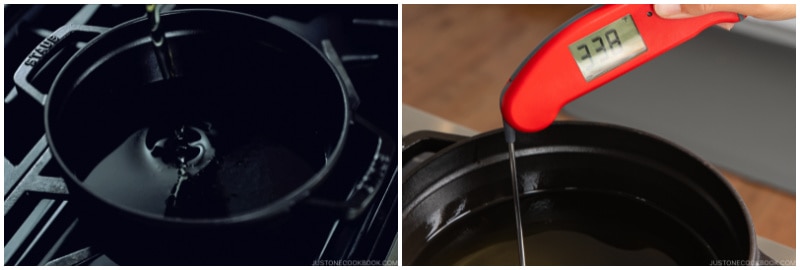
Gently put one pork cutlet into the oil and let it cook for 1 minute. Don‘t flip it or touch it for 30 seconds. Tip: Why one piece at a time? Too much food at once will drastically reduce the oil temperature, and the tonkatsu will absorb too much oil. You should see big oil bubbles when you add the pork. Also, monitor the oil temperature so it doesn't rise above 340ºF (170ºC). If it does, the breading will get dark before the pork is cooked and you meat will be undercooked.
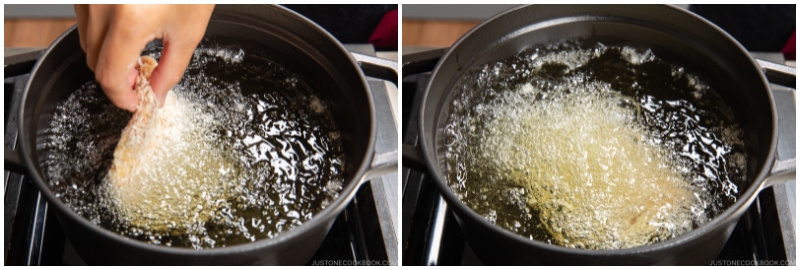
After a minute, flip the pork and cook the other side for 1 minute.
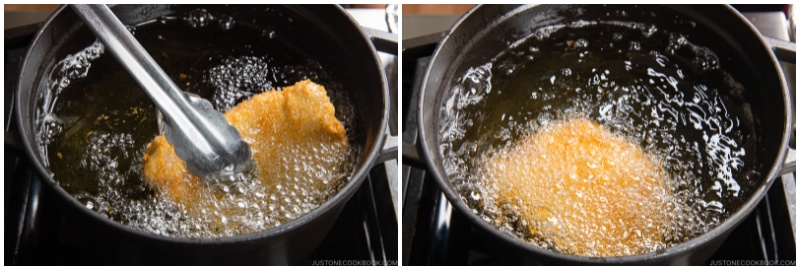
Remove the pork and let the excess oil drip off by holding the cutlet vertically over the pot for a few seconds. Place it on a wire rack or paper towel and prop it on its side, if possible, to drain excess oil. Let it sit for 4 minutes. The residual heat will continue to cook the meat as it rests.
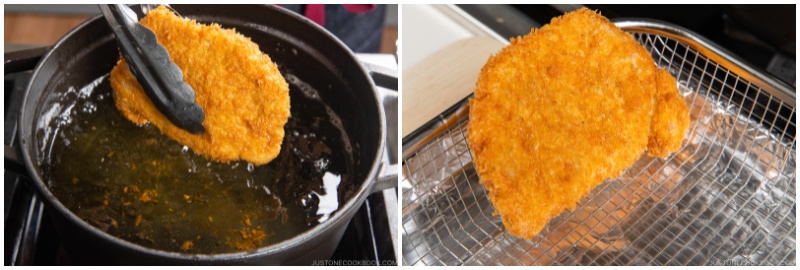
Turn off the heat temporarily. Scoop up and discard any fried crumbs in the oil with a fine-mesh strainer. Keep the oil clean of fried crumbs, which can burn and make the oil dark and dirty. Then, turn on the heat again to medium and bring the oil back to 340ºF (170ºC).
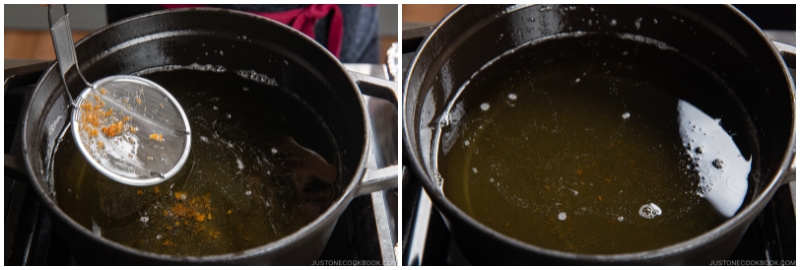
While the first cutlet is resting on the wire rack, deep-fry the second cutlet for 1 minute without flipping. Do not touch it for 30 seconds.
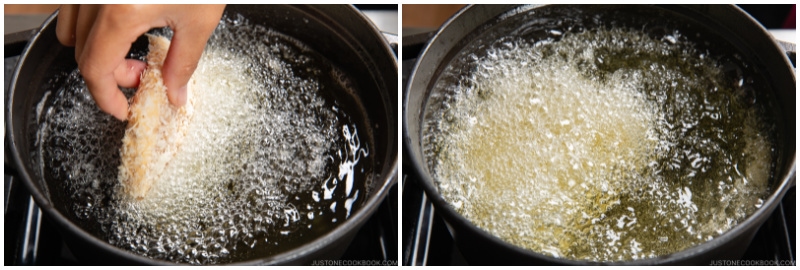
Flip and cook the other side for 1 minute.
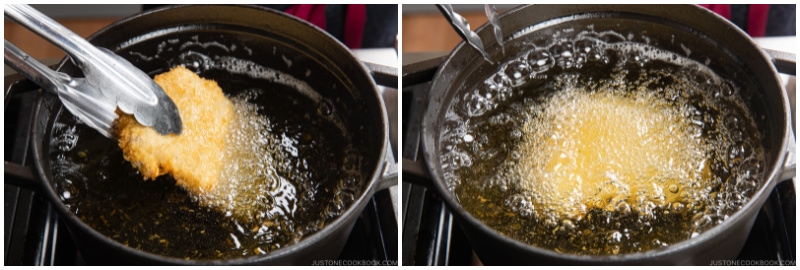
Take out the pork and drain the excess oil as before. Place it on the wire rack and let it rest for 4 minutes. Clean the oil of fried crumbs.
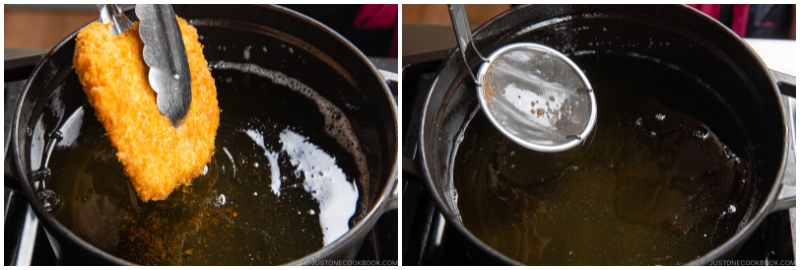
The Second Fry
Raise the oil temperature to 355ºF (180ºC). After 4 minutes, the first piece of pork is ready for its second frying. Fry the cutlet again for 30 seconds on one side, then 30 seconds on the other side. Remove from the oil, let the oil drip off, and drain on the wire rack for 2 minutes. This prevents the breading from getting soggy on one side.
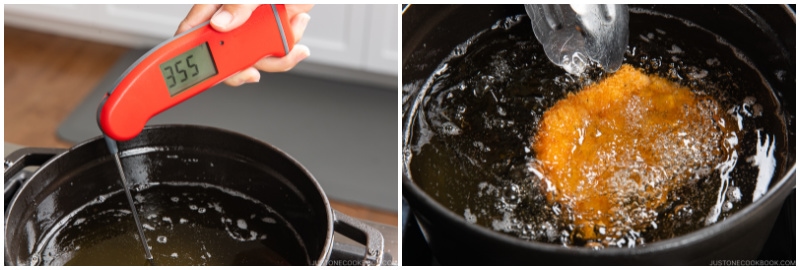
Clean the fried crumbs in the oil, then fry the second cutlet again. Remove from the pot and drain the excess oil as before.
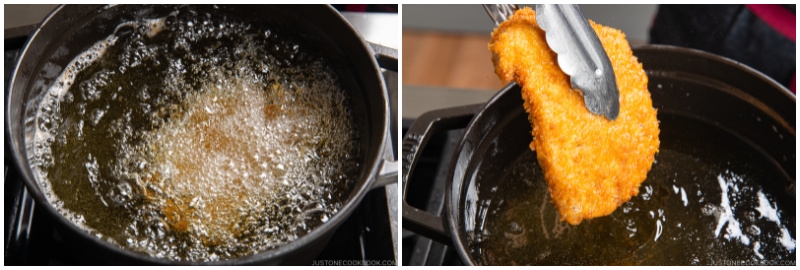
To Serve
Cut the tonkatsu crosswise into slices about ¾ inch (2 cm) wide.
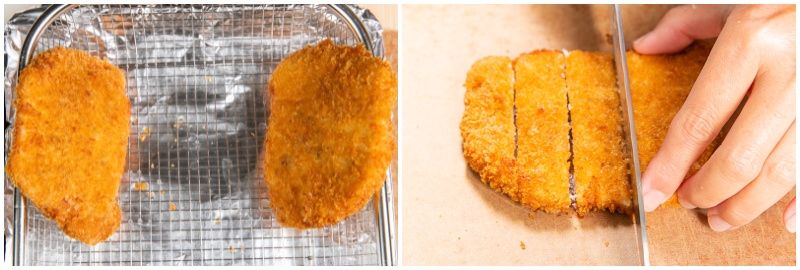
Transfer to a plate and serve it with the shredded cabbage and cucumber, the sesame dressing in small individual cups, and the sesame tonkatsu dipping sauce on the side.
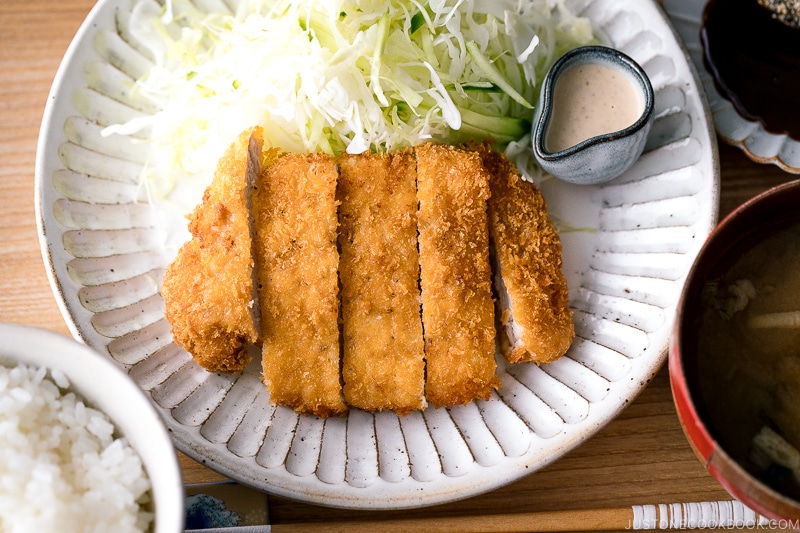
To Store
You can store leftovers in an airtight container and freeze for up to a month. To reheat, put the defrosted or frozen tonkatsu on a baking sheet lined with aluminum foil or parchment paper. Bake at 350ºF (180ºC) for 15–20 minutes if defrosted or 30–40 minutes if frozen. Check if the inside is warm before serving.
To Dispose of Used Cooking Oil
Please follow your local guidelines for disposing of cooking oil. In my neighborhood, we can take it to the recycling center and dump it into a designated container, so it’s very easy.
If you are using a Japanese oil solidifier, add the powder into the hot oil right after deep-frying and mix well.
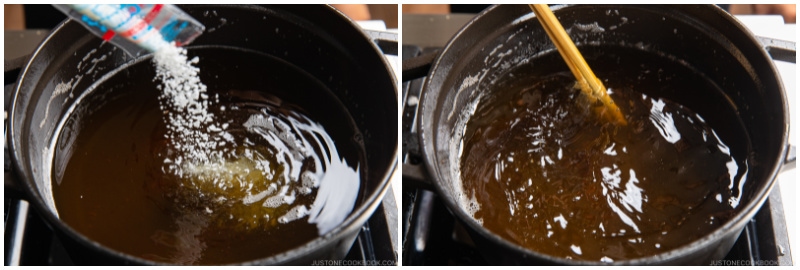
Set it aside and let the oil completely solidify as it cools, which may take overnight.
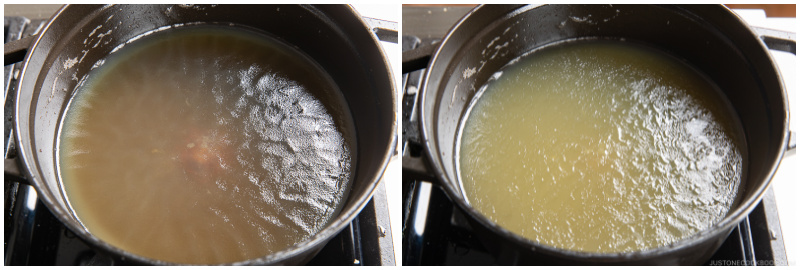
Cut into small pieces and discard them in the trash.
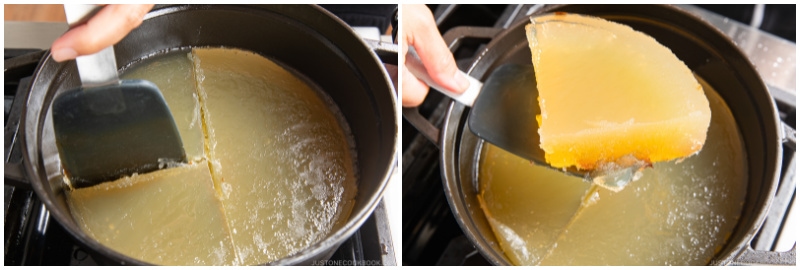
Calories: 523 kcal · Carbohydrates: 15 g · Protein: 27 g · Fat: 37 g · Saturated Fat: 7 g · Polyunsaturated Fat: 19 g · Monounsaturated Fat: 10 g · Trans Fat: 1 g · Cholesterol: 131 mg · Sodium: 491 mg · Potassium: 458 mg · Fiber: 1 g · Sugar: 5 g · Vitamin A: 96 IU · Calcium: 74 mg · Iron: 2 mg
Author: Namiko Hirasawa Chen
Course: Main Course
Cuisine: Japanese
Keyword: panko, pork
©JustOneCookbook.com Content and photographs are copyright protected. Sharing of this recipe is both encouraged and appreciated. Copying and/or pasting full recipes to any website or social media is strictly prohibited. Please view my photo use policy here.
If you made this recipe, snap a pic and hashtag it #justonecookbook! We love to see your creations on Instagram @justonecookbook!
Editor’s Note: This post was originally published on July 12, 2011. The post was updated with new video and images in August 2021. The post was updated with more helpful content on August 11, 2025.



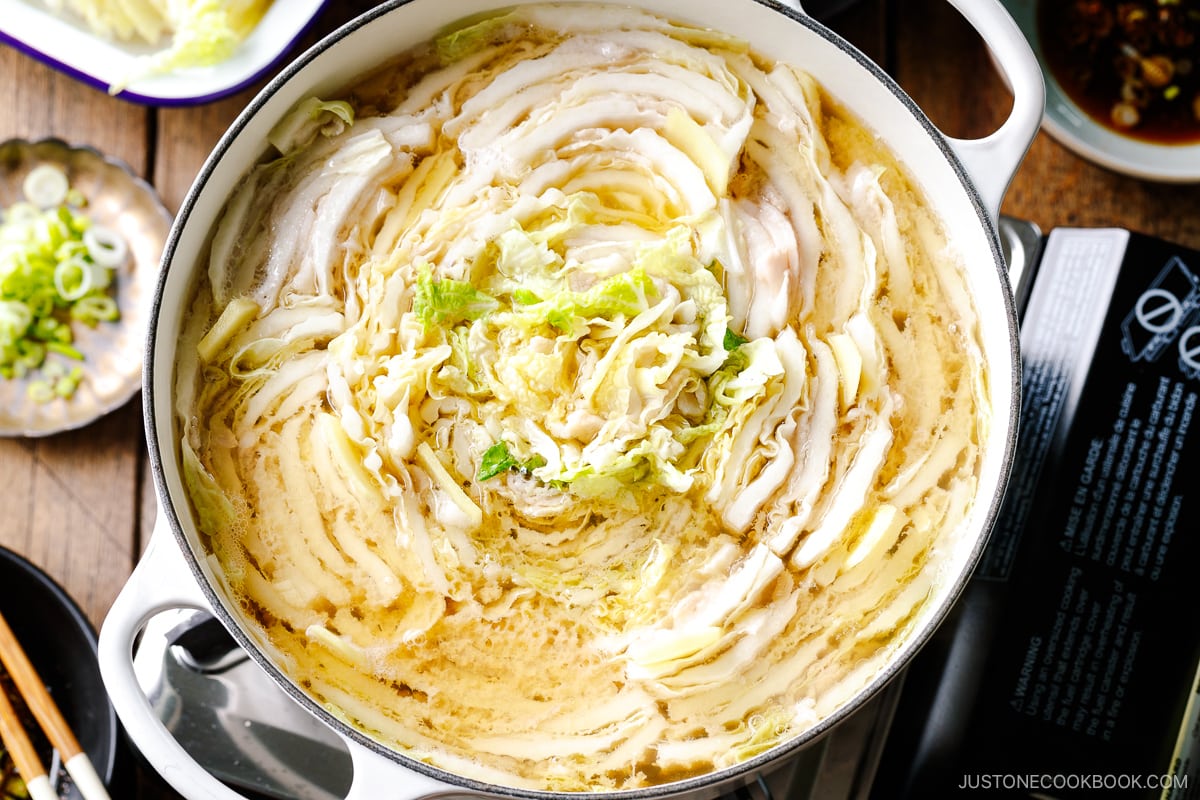







 English (US) ·
English (US) ·